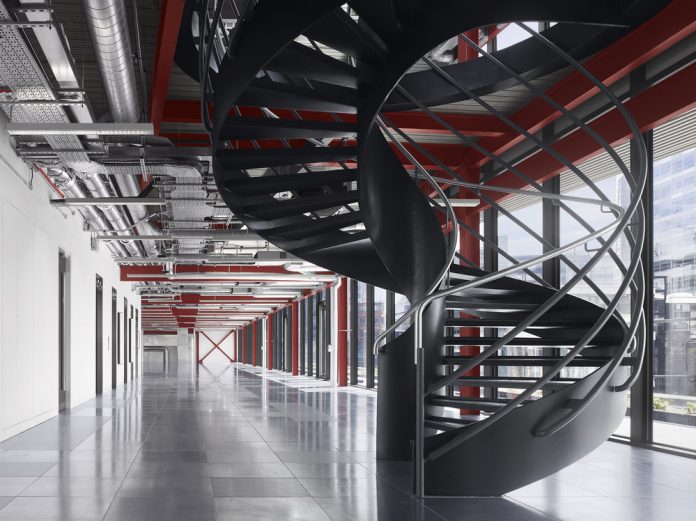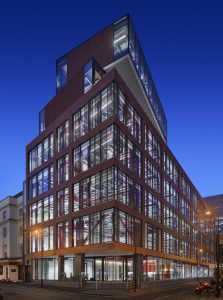Reskinning existing buildings could provide affordable housing for the capital at a faster rate without the negative impacts of demolition that can undermine the benefits of new builds. Richard Hyams of architect astudio takes a look
Every generation has come with up potential solutions to solve the UK’s housing issues. Post-World War II, it was a surge in prefab housing that was put forward as the answer. A couple of decades later it was the tower block, rising up to scrape the sky, and a symbol of the 1960s commitment to progress that was en vogue. In the past few decades, tearing down these blocks and replacing them with more modern buildings has been one of the hallmarks of residential housing development.
However, demolition comes with significant environmental costs, which undermines the efficiencies new builds offer, as well as our drive for a zero-carbon future. This is why reskinning, a process that utilises the existing frame of a building and extends it to meet new demands for space, energy efficiency and other factors, is increasingly being viewed as a key part of the approach to address the UK’s housing crisis.
Reskinning offers the potential to produce more affordable residential accommodation for Londoners at a faster rate and could be used to repurpose unneeded commercial properties for new accommodations. If widely adopted, it could open the door for a new, more environmentally conscious era in London’s skyline which conserves as much as it innovates.
London’s housing shortage is severe
There is a significant shortage of affordable housing in London, which continues to make the prospect of being a homeowner to most of the capital’s population an unobtainable ambition. Extortionately high rent prices, a highly competitive market and a general deficit of supply have created a nearly impossible situation for much of London’s lower income population, which drives them further from central London into the outer boroughs and neighbouring cities.
The need for affordable housing in London is also a significant contributor to the capital’s immense homeless population which, according to a 2019 Shelter report, registered over 320,000 with at least 5,000 rough sleeping. If we want to adequately deal with this shockingly high rate of homelessness in a lasting, long-term way, we need to be able to provide the homeless with access to affordable housing in areas close to central London where most people work. Currently, there simply aren’t enough options in these areas and boroughs and housing market trends indicate that they are only going to become more inaccessible, so a more creative approach is necessary.
Overlooked cost of new builds
Conventionally, a building in London has an estimated lifecycle of 60 years. Though many structures are used beyond this point, in particular historic buildings, many of the capital’s skyscrapers built in the 1950s and 1960s are nearing the end of their useful life. Their facades are old and out of step with modern architectural trends, their ventilation is poor, their energy ratings less than ideal, the windows failing and wiring unequipped to deal with the demands of our new, tech-heavy reality.
According to a study by the Institute for Environmental Design & Engineering (IEDE), the UK building stock comprises of an estimated 28m properties, 22m of which are residential and 6m of which are commercial. Each of these contributes a total of 26% and 18% respectively to the UK’s total CO2 emissions per year. An issue cited in this study is that most legislation and assessment of building’s CO2 emissions focus on its construction and general use but overlook other aspects of its lifecycle, including maintenance and, most importantly, demolition. To demolish a building not only requires massive amounts of energy, resulting in increased CO2 emissions, it also then invariably leads the construction of something new, bringing with it its own significant carbon footprint. Even if the new build is a carbon-neutral, eco-friendly structure, it comes at a significant environmental cost.
Furthermore, there simply aren’t enough new builds in development to address our housing shortage. According to the same IEDE study, 75% of the UK housing stock that will exist in 2050 has already been built, with new builds adding only 1% each year. This leaves a significant need for alternatives to new builds that offer a less wasteful, more environmentally conscious solution to the housing crisis.
Reskinning offers a potential solution
Consideration should be given to replacing the demolition/new build cycle still commonly used by many architects and developers with reskinning. Also known as retrofitting, this practice is an extreme renovation where an old, outdated and inefficient structure is stripped back to the concrete and steel frame – removing the facade, internal systems, insulation and anything else that no longer meets the standards of present-day construction. Concrete actually gets stronger with age and emits a great deal of CO2 when it is being made. By retaining a structure’s existing concrete frame and building on it rather than outright replacing it, the impact of the reskinning process is greatly minimised.
From this point, we sidestep the planning time drain of designing from scratch and instead build around and upwards on the existing structure, retaining historic lines of sight while adding adaptable, dynamic space that is consistent with our environmental objectives. By extending floor plates, installing new lifts and pushing out the building’s space as much as possible, we effectively create a new, better structure around the old, with minimal disruption to neighbours and discrete, safe waste disposal.
Reskinning opens the doors for future technologies
As new technological innovations begin emerging in the design and development industries, reskinning opens the doors for their wider, faster adoption on many of London’s pre-existing structures. A few examples of these are: facades that absorb and reuse carbon dioxide; green walls that convert carbon emissions into biofuel; glazing that acts as a radiator and a heat-shield in one; bioluminescent buildings that emit light to illuminate the streetscape by night; and self-healing structures that fill tiny fissures in their exoskeleton organically and automatically.
Because reskinning is a far simpler process than demolition and new build construction, as these new technologies become market-ready it could take less time for them to be more widely implemented, which would see their effect in reducing the UK’s CO2 emission levels realised sooner.
Covid-19 could free-up office space
With the Covid-19 outbreak shutting down most of London’s commercial offices and driving what some see as a long-term trend towards remote working, there is a potential that London’s commercial real estate sector could find itself with a surplus of available office space and not enough tenants to fill it.
Reskinning would offer landlords and developers a more cost-effective solution to repurposing commercial buildings for residential use, which would be able to deliver liveable, more affordable housing at a faster rate than new builds. If enough offices were reskinned for this purpose, we may be able to better address London’s housing crisis while making more of our buildings carbon-neutral, which would otherwise continue to operate inefficiently.
astudio’s old office was just such a structure. Built decades before, its usefulness and marketability were at an end, leaving the landlord really with only two options for what to do with it. Now that we’ve relocated, the building is slated for demolition in the near future to make way for something else. It’s a story repeated over and over again across London and every time it represents a missed opportunity for a less disruptive solution.
A crisis demands unconventional approaches
At astudio, we support this move to consider reskinning as contributing to the approach to addressing the UK’s housing crisis. As a team we strive to be research and innovation-focused in every project we undertake. Finding novel, creative and sustainable methods for tackling some of the biggest challenges facing the architecture and development industries is a core driver from the earliest stages of the design process to the last.
While retaining London’s history through the structures that have stood for decades, we envision a London skyline radically different from the one we see today. The majority of existing building stock will remain untouched, but through reskinning they will be repurposed to service the population for many decades to come.
We have already demonstrated the practical applications of reskinning with 70 Wilson, our commercial project in Shoreditch. Operating with a £21m budget, we took a 1980s office building and adjacent Grade II listed building and refurbished it in collaboration with Low Carbon Workplace to create a truly futureproof structure which meets modern low-carbon goals. We were also able to use the building’s existing frame to extend its net floor area by 25% through the rationalising of layouts and the addition of a two-floor roof extension.
Reskinning, if implemented widely, stands to produce a ripple effect of benefits by not only extending building lifecycles and reducing CO2 emissions, but also aid in tackling the London housing crisis by offering a faster, better way of producing more residential space for affordable housing. And while the management of older buildings remains one of the major challenges cities face as they try to make urban environments more sustainable, investing in an innovative solution is more important than ever.
Richard Hyams
Founding director
astudio
+44 (0)207 401 4100















